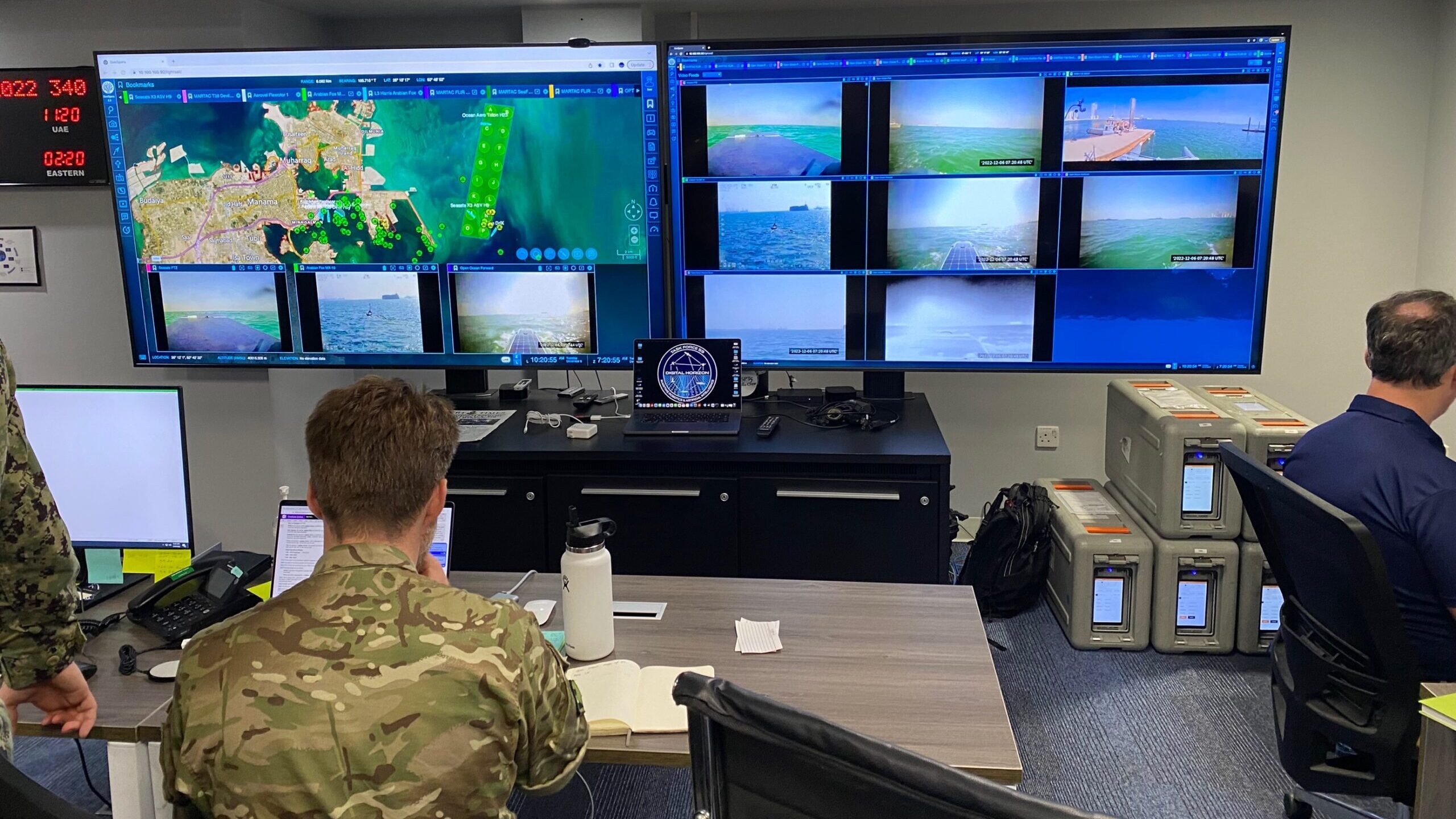
Navy operators in Bahrain examine data being fed to an operations center by various unmanned systems during the Digital Horizons exercise. (Photo provided by Accenture Federal Services.)
WASHINGTON — An industry vendor participating in the Navy’s recent unmanned systems exercise in the Middle East says it was able to command and control five unique drones from a single point of contact, a capability the Navy has long expressed an explicit interest in possessing.
The event, which started Nov. 23 and ends today, is called Digital Horizons, and was hosted by Task Force 59, a panel stood up by US 5th Fleet in September 2021 to experiment with how the service can incorporate unmanned systems into operations. In total, the Navy included 15 types of drones in the exercise.
Stephen Carlon, managing director of C4ISR at Accenture Federal Services, told Breaking Defense in an interview on Tuesday that his company’s part in the Navy exercise was primarily to aggregate data from the every drone operating off the coast of Bahrain and then visualize it in an easy-to-read format for Navy officials. To do that, Accenture used two systems: a data aggregator called “Picard” and a web-based data visualization application called “GeoSpera.” At the same time, the company also adapted five of the drones so the Navy could control them through GeoSpera.
Using that program “we were able to task individual platforms, and actually the naval operator themselves were able to say, ‘I want this vessel, this USV, to move to this particular point,’ and they were able to make that command within the single pane of glass,” said Carlon. “The USV autonomously then was able to navigate to that point, without any intervention from the industry partner who was operating the USV.”
RELATED: Peraton developing ‘single-pane-of-glass’ visibility across Army’s unified network
The phrase “single pane of glass” refers to the computer screen space the Navy dedicated to displaying the data aggregated from the various drones — a term also used by the Army in its all domain efforts. Accenture was one of two companies at the exercise not contributing a physical unmanned system, but rather working with Navy analysts on the back end to collect and process data.
Carlon said Accenture was chosen for that role through a Defense Innovation Unit competition held earlier this year focused on data aggregation and visualization. The other company participating in Digital Horizons but not contributing an unmanned vessel was Big Bear AI, which used its machine learning solution, Ursa Minor, to analyze the incoming data streams.
“Ursa Minor conflates millions of data points to provide situational awareness, predictive forecasts, and computer vision capabilities to analysts and decision-makers in real-time,” Big Bear AI said of its technology in a statement about the event.
Carlon said the company didn’t try to command and control more than five vehicles because of the time it takes to integrate the drones with GeoSpera as well as the practicality regarding which vehicles had tasks that would benefit from such a capability.
Accenture’s demonstration brings to fruition a capability the Navy has long said it wants for its own unmanned fleet: controlling different unmanned vehicles from a single point of contact. It’s not an easy task, due in part to how USVs receive and transmit data, Carlon said.
“Standards are one of those things that sort of build up over time,” he said. And when it comes to the communications pathways unmanned surface vessels use to transmit and receive data “there’s not really a standard around how they speak.”
That very problem is one with which the whole Pentagon is dealing, but cuts to the core of internal Navy efforts aimed at standardizing much of the technology utilized in its future unmanned fleet. It’s a big undertaking and while some progress has been made for using specific platforms, the larger solution likely won’t be ready for the wider fleet in the near term.
In the meantime, Carlon said Accenture’s approach may offer an interim solution: pick and choose which USVs offer worthwhile capabilities and take up the task of integrating each individually.
“It allows you to really do that cost trade off to say, this platform just has an amazingly exquisite set of capabilities [and] I, as the Navy, can still consider them because I have a platform that can speak to them, even if they’re doing it in a non-standard way,” he said.
Global military spending hits ‘all-time high’ of $2.4 trillion: SIPRI report
The US remains the world’s largest defense spender, outlaying $916 billion last year, a 2.3 percent annual increase, ahead of China in second place, which spent an estimated $296 billion, a 6 percent increase over the same period.



























